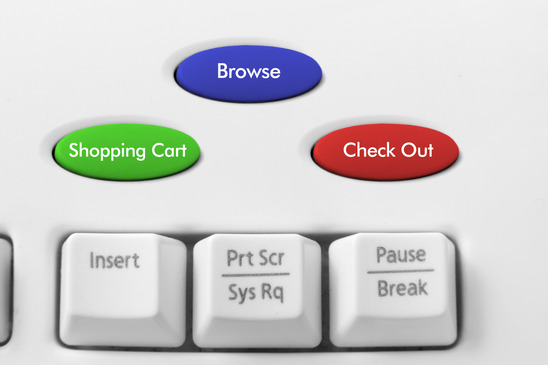- Our Products
Not sure what product? Compare them here
- Pricing
- Success Stories
- About Us
- Login
- Get Started Now
So, I’ve got good news and bad news for you. The good news is that the average person can make a very good income by selling merchandise through an eCommerce website. The bad news is that achieving that income level will take a lot of patience, persistence, hard work, creativity, and research.
The main key to eCommerce success is consistent sales, because without consistent sales you do not generate a steady stream of revenue. Giant retailers such as Walmart and Amazon.com make vast amounts of money because they have consistent sales.

Achieving consistent sales takes time, knowledge, and experience. The only way to get that knowledge and experience is to actually get in there and start selling!
But you may feel a little overwhelmed by the process as a whole. "Where should I start?" you might ask, or "how do I get those consistent sales?" But I'm here to give you everything you need to get started and achieve success in eCommerce.
Let’s begin!
The great thing about online retail is that it is so easy to get started. Some eCommerce platforms, such as eBay, Amazon.com, eCrater.com, and Bonanza, let small-scale sellers list for free. Others, such as SaleHoo, offer low-priced online stores. Just getting started with one platform is important because the experience will teach you the basic skills of managing an eRetail store, and it will build your confidence.
The best way to get your feet wet in online retail is to look around your house and find something that you can sell and ship easily. This can include collectibles like comic books, old books, software, video games, DVDs, and so on. Small items like watches, antiques, and old tools sell quite well. Once you’ve identified something that you can sell, list it on eBay.

Making an effective listing is easy: All you’ll need is a good title, a clear description, and a good picture of the item. It's easy to learn how to write an effective listing and description, too. Just go into a selling platform and look at descriptions for similar high-selling products.
When you’re selling, a picture is worth a thousand words, which is why eBay now requires pictures of all merchandise. The best way to get images of books, magazines, and comics is to scan them using a flatbed scanner. You can take photos of other kinds of merchandise with a camera or a smartphone. When you create a listing, make it look as professional as possible by cropping and adjusting the picture. If possible, add more than one image.
When you list, you will need to use a method of electronic payment. PayPal, which is owned by eBay, is the most popular, but there are alternatives such as MoneyBookers and ProPay. Setting up a PayPal account is free, and you don’t need to have any money in the account to start.
So now you’ve got a listing. Start selling and keep selling; if you run out of items from around the house, scour the neighborhood and the city for more stuff to sell. Garage sales, estate sales, flea markets, thrift stores, car boot sales, and charity events are great places to look for additional merchandise. I’ve even sold books that I’ve found off the street on eBay.
The objective of your sales is to raise enough money to purchase a small wholesale lot and move to the next level. A good way to do this is to not spend any of the money you raise from the sales. Instead, keep it in an account and set a goal, say $500 or $1,000. When the funds reach that level, you can reinvest them in a small wholesale lot and an online store.

You can set up a basic online store through SaleHoo for just $27 a month or a basic store on eBay for $15 a month. This may be the most powerful investment that you’ll ever make.
The key to generating consistent sales volume is market research. Effective market research will tell you which products are selling and which products are dead in the water. You should perform market research as soon as you start selling online, and you should never stop.
The cheapest source of knowledge is plain old-fashioned reading. Familiarize yourself with the basics of business and economics. The Internet is a great source of information, but so are books and magazines. Try and keep up with the industry and the basic trends. SaleHoo blog posts and free lessons are a tremendous source of information.
Another great source of information that many people neglect is reports from government agencies. Reports from agencies such as the United States Bureau of Labor Statistics contain detailed information about many sectors of the economy. The reports can tell you what industries are expanding and which regions of the nation are enjoying economic growth.
After knowledge, you’ll need actual sales figures to see what items are selling and how much they are selling for. The best place to get that kind of data is from online tools such as SaleHoo’s Market Research Lab.
The Market Research Lab is actually a search engine where you can type in the item that you are interested in. The lab gives you two important figures that will help you identify merchandise that you can actually sell for a profit. These figures are:
Another great source of information is eBay. By checking the listings on eBay, you can determine the level of competition for items, as well as the average price. One key piece of information you can learn from eBay is who your potential competitors are.
Yet another source of information you should investigate is other sellers. The forums on sites such as SaleHoo often contain large amounts of information, some of it written by veteran sellers who have years of experience. The veterans can teach you effective sales techniques and help you avoid mistakes.
Once you’ve identified a product to sell, your next step is to locate a good wholesaler. This can be difficult because there are a lot of shady wholesalers and fly-by-night operators online.
The best way to avoid these characters is to use a reputable sales platform such as SaleHoo. SaleHoo can help you make contact with more than 8,000 wholesalers. Take time with your search, because having a good wholesaler is vital to eCommerce success.
Verify the wholesaler’s reputation and background before handing over any money. A way to do this is with a simple Google search. If there are a lot of complaints about a wholesaler, a Google search should turn them up. Another great way to check out a wholesaler is to ask about them in the online forums at SaleHoo. If the wholesaler has a bad reputation, you’ll soon hear about it.
Checking the age of a wholesaler’s website is also a good idea. DomainTools.com can tell you a website's age. It’s best to avoid sites that are less than 12 months old because they could be fly-by-night operators.
Once you locate a reputable wholesaler, you must determine whether they provide drop shipping. Drop shipping means that they will ship merchandise directly to your customers.
The biggest advantage to drop shipping is that it is also a great market research tool. Since you can buy a small amount of merchandise, you can test to see if an item actually sells. Drop shipping small lots of merchandise also teaches you how to manage sales, which is one of the most important eCommerce skills that you’ll need to learn.
Sales management is another very important eCommerce skill, and there’s only one way to learn: You’ve got to sell stuff! The more you sell, the more you’ll learn about sales management.

The first and most important rule of sales management is to get paid. Learn how to verify payment, and never ship an order until it’s been paid for. This is one of the biggest advantages of online payment platforms such as PayPal: They will let you know when you get paid. PayPal will actually send you an email when you receive a payment.
Verifying payment is the easy part. The hard part is fulfilling the order. The good news here is that when you drop ship, the drop shipper takes care of the fulfillment. Some of the benefits of drop shipping include:
The key to maintaining consistent sales is to have the merchandise in stock when the customer orders. That means you must restock your inventory by ordering more merchandise. But how often should you do this?

A really good rule of thumb is to restock when you have sold 50 percent of your merchandise. The 50 percent restocking rule is a good one because it ensures that you only order more when something is actually selling. This rule ensures that inventory will be available when customers order an item. It also helps you cover costs because you can use the profits from the first 50 percent to cover the next order.
The key to increasing sales volume is to increase your wholesale purchases as your sales rise. Purchasing in greater volume is the key to raising profits because most wholesalers provide a bigger discount when you make larger orders. For example, a wholesaler might give you a 20 percent discount for ordering 1,000 items, compared to a 10 percent discount when you order 500.
Another advantage to buying in bulk is that wholesalers will be more likely to offer you vendor credit. That means they’ll invoice you for merchandise rather than making you pay for it up front. When you start, most wholesalers will require that you pay directly with a debit or credit card.
The key to maintaining consistent sales is to have really good listings that attract new customers. There is no such thing as a perfect sales listing; any listing can be made better.
Be willing to change the title, description, and photographs whenever you think of something different. A good way to find what works is to keep looking at your competitors’ listings, and if you see something you like, recreate it. And please don’t be afraid to make several variations of the same listing to see which one sells best, because testing is one of the most important steps to eCommerce success.
When you create your listings, don’t neglect one of the most powerful marketing tools ever invented: the testimonial. Nothing promotes a product better than a real person touting its benefits. A good way to get testimonials is to email satisfied customers and simply ask them for one.

Some keys to creating an effective testimonial include:
The best aspect of online retail is the freedom that it provides you to experiment. You should view eCommerce platforms as a laboratory in which to experiment. Successful entrepreneurs are constantly experimenting with new means of increasing their sales, so you should definitely experiment with selling on multiple online platforms. Once you’re successful on eBay, give Amazon.com or SaleHoo a try.
Some other popular eCommerce platforms include:
Try to find out if there is a niche platform dedicated to selling your merchandise. Such platforms are also a great way to drive additional customers to your listings.
Selling on different platforms is a great way to test out new products and to expand your customer base. Something to remember is that there are a lot of people out there who don’t like eBay.

When you’re truly experienced at eCommerce, you’ll be ready for the ultimate experiment: setting up your own retail website. There are two major reasons why you’ll want to build your own eCommerce site:
One of the best resources for developing an eCommerce website is SaleHoo, which specializes in online wholesale. SaleHoo provides a tremendous amount of support, including a comprehensive seller training center that will give you information you need to succeed. SaleHoo even provides the tools to create basic online stores.
Another good resource is GoDaddy.com, which provides one-stop shopping for a wide variety of eCommerce services, including web hosting, domains, and website construction.
If you’re confused, check out SaleHoo’s Seller Training Center, which provides detailed lessons on many aspects of eCommerce, including eBay sales, drop shipping, and website building. The Seller Training Center is one of the best places for those with little or no knowledge of eCommerce to learn the basics.
If you’re interested in online selling, why not give it a try by going to eBay and listing a few small items? Remember, the best way to learn how to generate income through online retail is to start selling now.
But if you want to speed up your progress, join SaleHoo. SaleHoo provides everything you need to find hot products to sell, from trusted suppliers at great prices. Better still, SaleHoo Stores gives you a tailor-made solution for where to sell your products.
Get your own online store live and ready within just minutes. No technical knowledge is required! Learn more about the ways SaleHoo is already helping more than 100,000 retailers.

A couple of months ago I began selling items around my house on ebay. When I ran out of items I began surfing the web looking for different ways to make money and finding site after site advertisin...read more
A couple of months ago I began selling items around my house on ebay. When I ran out of items I began surfing the web looking for different ways to make money and finding site after site advertising everything from drop shipping to club memberships promising riches, cookie cutter websites....you name it, I read about it. When I ran across an ad for Salehoo it interested me because it appeared to be a place where I could do a lot of research without having to bounce from site to site and I must say, I am very pleased with my decision. If your like me and you don't really know what route you really want to take, a couple of hours of reading on the forums and navigating the site will have your head spinning with so many different avenues and after a few weeks I finally narrowed it down to what I was interested in and here I am. I contacted a supplier that I found on Salehoo and after reading all of the reviews about the company and asking about them on the forums I decided that I wanted to do business with them. I just received my first pallet of merchandise and have unpacked it and can't wait to get my items out into the market place. If your looking for someone to point you to the goose that laid the golden egg, well, just remember where that saying came from....a fairy tale and that's most likely what your gonna get but on the other hand, good information in itself is worth it's weight in gold and there's a difference between taking a gamble and taking a risk. Will my personal venture be a success? Well, there's always risk when starting something new but from the information I have been able to obtain from Salehoo, I feel that I am making an intelligent, educated risk concerning my venture as opposed to a gamble which is what most of the money making sites out there are trying to convince you to do so wish me luck! ...and a big Texas thanks to Salehoo and the friends that I have made in the Salehoo community.
